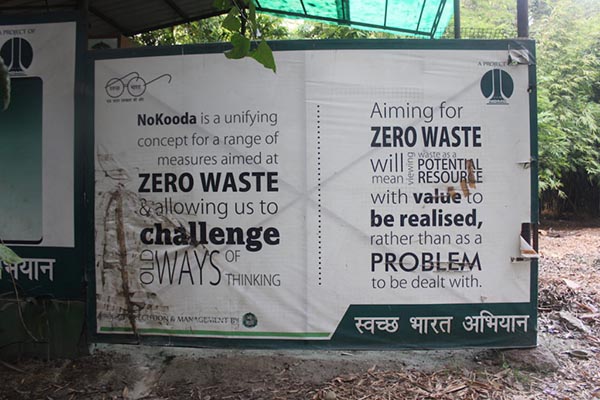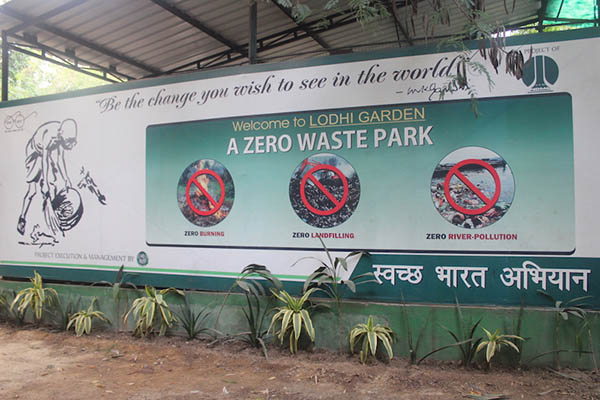
Signboard at Lodhi Garden, Delhi, India. Photo by the author.
When the Indian government promoted the large scale introduction of solar energy for powering traditional charkhas (wooden wheels used to spin khadi or homemade cloth) in early 2016, the fabric was rebranded “zero carbon” and sold as “green khadi.” Few journalists covering the new development seemed to notice that khadi in its original form was already zero carbon: woven on wooden spinning wheels without electricity or additional machinery, the production process of khadi is inherently environmentally friendly.
The rebranding of khadi as “zero carbon” in the face of its waning popularity marks a decisive cultural shift away from traditional frameworks in which the cloth has historically been given importance. Khadi has historically represented the overthrow of colonialism, the virtues of labor, and the mantra of self-reliance popularized by Gandhi during the freedom struggle. In the early twenty-first century, however, khadi is being rebranded for an environmentally conscious global market. The invocation of “zero” is hardly incidental in this context. That number has recently (forgive the pun) colonized our collective imagination of what it means to be “environment friendly.”
Evidence for this claim can be found in a small, but fast multiplying lexicon of “zerologisms” that have begun influencing policy and economic discourse. Terms increasingly taken for granted in environmental discourse include: zero carbon, zero waste, zero landfill, zero emissions, (net) zero energy. The zero has, in effect, become a conceptual placeholder, offering up an ideal on which we can pin our hopes as we search for ecologically sensible political alternatives that don’t necessitate a complete overhaul of how societies are structured. This latter point is crucial—for is there not a paradox in wanting to grow and prosper economically by “becoming zero?“ How can zero—nothingness—symbolize futurity and economic prosperity? By examining two dominant Western imaginaries of zero and then pairing them with examples from India, I will suggest that zero performs effective material and ideological work precisely because it simultaneously indexes both nothingness and infinitude.

A visual of the balance metaphor, explaining Net Zero Energy Buildings on the Government of India’s Net Zero Energy Buildings Portal. Source: USAID PACE-D, www.nzeb.in.
Circles and balances
Environmentalists in the United States mobilize the zero through two main conceptual forms: a closed circle and a metaphorical sense of balance. The concept of the circular economy literally indexes the zero as a circle or closed loop, as in the zero-waste community. The ideal of zero-waste attempts to reconfigure production processes to incorporate waste back into social commodity chains. The increasingly popular phrase “cradle to cradle,” used to describe this process, conjures up an imaginary where there is no away: all materials recirculate (presumably, for perpetuity). The circular economy has recently exploded, with Google announcing last year that it plans to go circular with help from one of the leading proponents of this form of thinking—the Ellen MacArthur Foundation. Nor is Google alone: the increasing popularity of the circle as a new image of economics has drawn in other corporations like Philips, Unilever and Cisco. In an eponymous book, John Elkington has even called innovators of this kind “zeronauts,” defined as “an inventor, innovator, entrepreneur, intrapreneur, investor, manager, or educator who promotes wealth creation while driving adverse environmental, social, and economic impacts toward zero.”
The second conceptual form of zero is balance, a perpetual calibration of possible environmental harm with steps taken to offset such harm, as in the image above from the Indian government’s web portal for Net Zero Energy Buildings. Balance frequently lurks behind terms like “zero carbon,” and “zero energy,” where zero is the outcome of a carefully worked out (“balanced”) equation. The logic of the argument goes something like this: if you burn some fossil fuels here, plant ten trees there to offset the effects of the carbon released. Zero landfill is possibly unique in this regard, given that those who aim to achieve it mobilize zero to designate an actual nothingness, a nonexistent landfill. When this state is achieved by burning left-over waste for energy, however, the fetishization of material nothingness only contributes to the production of more carbon dioxide. Those who advocate waste-to-energy processes counter that the carbon dioxide produced is still better for the environment than methane, the gaseous byproduct of landfills (which is potentially more environmentally harmful than CO2).
We could laud or critique both of these approaches to zero. The laudable part is self-evident: striving for zero—either through circularity or balance and offsetting—displays the birth of a global environmental consciousness. On the other hand, when raised to the level of a mantra, such efforts end up potentially creating new kinds of bureaucracies, certification mechanisms, and regimes of opacity, along the lines of what Keller Easterling (2014) calls “extrastatecraft.” Moreover, the circular and the balanced all too often offer blueprints to achieve zero that don’t interrogate the larger, structural idea of economic growth that still powers the policy economy. Paradoxically, this often means that economies must grow in order to reach the level of technical advancement required to achieve zero.

Signboard at Lodhi Garden, Delhi, India. Photo by the author.
The beginning of everything
I often encounter zero in my fieldwork on intersections of spiritual and economic energy systems in India. Like energy, zero straddles the spiritual and the secular, carrying a peculiar nationalistic resonance. Indians claim invention of zero’s modern, secularized form in the 7th century AD, but also frequently cite longer mythological and spiritual roots for the concept dating back millennia. In an article on the Government of India’s Ministry of External Affairs website, prominent pop-mythologist Devdutt Pattanaik describes how the “Hindu worldview has always been obsessed with infinity (everything-ness) and zero (nothingness) and with the number one (the beginning).” Pattanaik argues that it is this “philosophical obsession with infinity and zero” that led not only to the conceptualization of zero on the subcontinent, but also figuration of the number as a dot and the development of the decimal system. Similarly, the immensely popular sage Sadhguru writes in a blog post on his website that yoga “is the technology to make ourselves into a zero because zero is not a simple thing. Zero is infinite, it is the very beginning of everything.” Pattanaik and Sadhguru represent broader cultural trends that connect the zero simultaneously to both nothingness and infinitude.
These categories—nothingness and infinitude—play on my mind as I attempt to grapple with the large scale deployment of high and low tech solar energy systems across the country. India’s Ministry of Environment, Forests and Climate Change happens to be housed in the country’s first Net Zero Energy Building. As I encounter this exemplary building, with its top-of-the-line rooftop solar panels and inbuilt geothermal heat exchange systems, I cannot help but think of the ways in which here, a high tech net zero meets low tech net zero. Many un-electrified rural households affected by policies decided in this building are, after all, inadvertently net zero, even though they cannot be branded as such. The zero only appears in policy discourse alongside certain levels of consumption, most commonly in urban areas.
“Becoming” zero
Herein lies the paradox of the zero: it only becomes visible in policy discourse within an explicitly consumption-based context. It only becomes desirable when you can attain “zero-dom” through, say, the installation of solar panels, the offsetting of negative impacts, or the creation of a closed, systemic, circular consumptiveness. As a floating signifier (that is, unmoored from any referent), zero in environmental discourse draws strength precisely from its ability to simultaneously index nothingness and infinitude, but here these concepts operate at different registers than the ones I described above. The ideological and material work that the zero seems, ultimately, to perform is to maintain the fiction that we can have our cake and eat it too. It lets us constantly consume, and then calibrate—in order to “lighten the footprint”—and allows us the comfort of not having to reimagine the potential limitlessness of consumption.
References
Elkington, John. The zeronauts: breaking the sustainability barrier. Routledge, 2012.
Easterling, Keller. Extrastatecraft: the power of infrastructure space. Verso Books, 2014.
